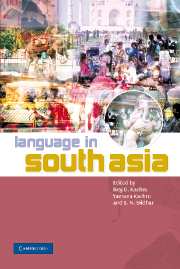Book contents
- Frontmatter
- Contents
- List of Figures
- List of Maps
- List of Tables
- Preface
- Acknowledgments
- List of Abbreviations
- Note on Transcription
- Introduction: languages, contexts, and constructs
- Part 1 Language history, families, and typology
- Part 2 Languages and their functions
- Part 3 Sanskrit and traditions of language study
- Part 4 Multilingualism, contact, and convergence
- Part 5 Orality, literacy, and writing systems
- Part 6 Language conflicts
- Part 7 Language and modernization
- Part 8 Language and discourse
- Part 9 Language and identity
- Part 10 Languages in diaspora
- References
- Subject Index
- Language Index
- Author Index
Introduction: languages, contexts, and constructs
Published online by Cambridge University Press: 04 May 2010
- Frontmatter
- Contents
- List of Figures
- List of Maps
- List of Tables
- Preface
- Acknowledgments
- List of Abbreviations
- Note on Transcription
- Introduction: languages, contexts, and constructs
- Part 1 Language history, families, and typology
- Part 2 Languages and their functions
- Part 3 Sanskrit and traditions of language study
- Part 4 Multilingualism, contact, and convergence
- Part 5 Orality, literacy, and writing systems
- Part 6 Language conflicts
- Part 7 Language and modernization
- Part 8 Language and discourse
- Part 9 Language and identity
- Part 10 Languages in diaspora
- References
- Subject Index
- Language Index
- Author Index
Summary
There are multiple constructs of South Asian language contexts. The region has been characterized, in great exasperation, as a linguistic “problem area,” a proverbial Tower of Babel. These metaphors apply to South Asia as a whole, to the State of India, and to each distinct region. A penetrating observer of Indian society and culture, V. S. Naipaul, portrayed this land of his ancestors as “a country of a million little mutinies.” But the crises of the mutinies, reassures Naipaul, “were the beginning of a new way for many millions, part of India's growth, part of its restoration” (1990: 517–18). Naipaul, of course, was not specifically thinking of the region's language conflicts, but if he were, he would not be entirely wrong. Those linguistic mutinies, the long history of the subcontinent tells us, have ultimately proved to be creative conflicts in many ways.
The Indian subcontinent comprises seven sovereign states: India (population 1,095,351,995), Pakistan (165,803,560), Bangladesh (147,365,352), Nepal (28,287,147), Sri Lanka (20,222,240), Bhutan (2,279,723), and Maldives (359,008). But linguistically speaking, these political divisions cloud the extensive underlying – and deeply shared – chronicles of literary and sociolinguistic histories of the present seven states of the subcontinent. The major language families of South Asia are Indo-Aryan, Dravidian, Tibeto-Burman, and Munda. The region's diversity also manifests itself in religious pluralism, representing Buddhism, Christianity, Hinduism, Islam, Jainism, Sikhism, and Zoroastrianism.
The South Asian region comprises almost 25 percent of the global population.
- Type
- Chapter
- Information
- Language in South Asia , pp. 1 - 28Publisher: Cambridge University PressPrint publication year: 2008
- 6
- Cited by



